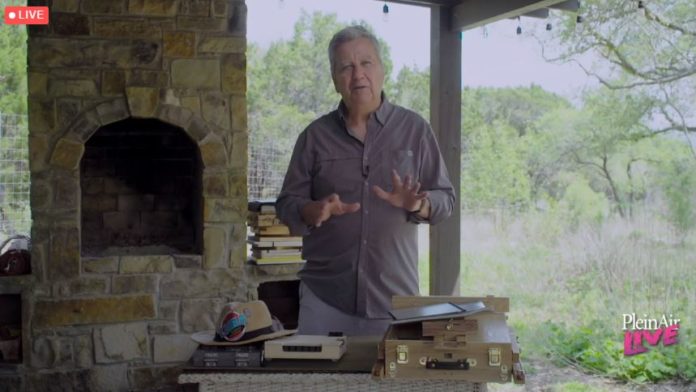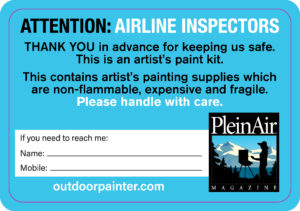Artists have many questions when it comes to traveling with art supplies: Are paints allowed on planes? Should paints be in your checked luggage?
If anyone knows about traveling with art supplies, it’s our CEO and Publisher, Eric Rhoads, who is a seasoned pro. Eric flies to beautiful locations multiple times every year to paint en plein air, and he has the answers you’re looking for.
In addition to this helpful information, you can also download this free travel sticker for artists when you sign for our free daily email, Plein Air Today. This newsletter will bring you helpful tips for painting outdoors, the best equipment to use, important art news and more!
Here is our exclusive Q&A, including some tips from additional friends of Plein Air Today:
CherieDawn: What are the main art supplies that you always bring with you for painting en plein air?
Eric: My goal is to make my life easy when traveling with paints and an easel. To start, I went to a discount store and bought the lightest, biggest suitcase I could find. It’s a hard shell, and in it you’ll find everything I could possibly need.
For instance, there are the things I need for that particular trip, which includes enough panels, my backpack with my easel, and paints that I typically use to paint outdoors.
But there are also things I rarely use, which will sit in the suitcase in the back of my car until I need them. This includes:
- a raincoat
- a winter coat with gloves, hat, scarf, and hand warmers
- tall rubber boots that are insulated for winter
- my umbrella
- a small camping chair
- enough panel carriers to get all my paintings home
- Some extra tubes of paint in the colors I tend to use a lot.
- a multi-tool
- bug spray, sunscreen, and a couple of different kinds of hats in case the sun is intense
- a folding walking stick (in case I want to walk into a slippery river)
- a second mini-easel (I’ve been on trips where my easel broke, and I was stuck)
- a large bottle of non-flammable brush cleaner (not glass) sealed in plastic or plastic wrap
- a few zip lock bags
- a small watercolor set and small pad, for quick easy sketches.
- as many paper towels as I think I’ll need on the trip.
The suitcase I use is on wheels, and it gets heavy; before leaving, I check the whole thing.
Note: I don’t carry razors. The airport will very likely confiscate them. I’ve had them also take palette knives from my checked luggage, but I still bring them; having a plastic one just in case is helpful. I’ve had paints taken as well, but not since I’ve started using the travel sticker.
Regarding panels, I prefer them in the field because canvas is what sails are made of and stretched canvas will sail off your easel. I learned years ago to standardize on two sizes. I pick 9 x 12-inch and 12 x 16-inch. Often I’ll have a carrier with both, just in case I don’t have time for a 12 x 16.
What’s in my backpack:
My goal is to travel as light as possible, and to not have anything else to carry other than my backpack. I see people with big roller carts, carrying their entire studio. They are exhausted after walking a quarter mile. I can walk to the top of a mountain with my backpack. Invest in a well-made backpack with good padding. It makes a difference with a heavy load. Here’s a list of what’s inside my backpack:
- Sketch pad, pencil, gray markers
- Hat
- Plastic bags
- Paper towel
- Folding carbon fiber (strong and light) tripod
- Two-panel carrier with two panels
- Small pochade box easel
- A fish tackle box with my paints. Paint is heavy. Reduce your palette for weight.
- Brush holder and brushes
- Easel Brush Clip and Value Specs
- Can for brush cleaner
- Bottle of water
- Lanolin based baby wipes (for cleaning paint)
CherieDawn: What art supplies do you typically carry on when traveling by plane?
Eric: I never carry anything on. It’s all in my suitcase. You cannot carry paint or solvent.
Some people take their easel as carry-on, to prevent breakage. I have had several easels broken when I would check my backpack (often the glass palette). Since I started my suitcase, none have broken, but I don’t travel with glass palettes. I use palette paper.
CherieDawn: What supplies do you leave at home?
Eric: I don’t travel with solvent. I paint solvent-free at home and outdoors.
CherieDawn: Are there any supplies that you ship in advance?
Eric: Rarely do I ship. It’s costly and I can check my bag and have everything with me. I’ve never lost my bag but have lost art supplies that I shipped for plein air painting trips. I did once ship some solvent to Russia, but it was expensive to do so, and I don’t use it any more. Mostly I avoid shipping for convenience, and I usually paint the day I arrive.
CherieDawn: Do you have any memorable stories about traveling/flying with your paints?
Eric: Nikolai Dubovik, the great Russian Master, visited me at my summer cabin for a week, where we painted together. He checked his bag when we went to the airport, and when he arrived at his destination, all of his Russian brand paints had been removed, including colors you cannot get here. He had to go buy paints for the rest of the trip. That’s why we offer a free travel sticker. (Editor’s note: Click here to download our free travel sticker for artists and get the free Plein Air Today newsletter)
Once I flew to Russia for a tour and painting, but I needed solvent. My driver did not speak English but somehow I finally communicated that I needed an art store. He took me to this dark, dingy place and everything was behind the counter. I didn’t know how to explain what I needed, so I left without solvent, and had to paint without it, which is another reason I gave it up. Now I use solvent free gels, which are non-flammable.
***
Here are some more tips on traveling with art supplies from our friend at Plein Air Today, Bruce Bingham:
- Visit the websites of art supplies manufacturers. Some of them list the material details, and you can print these out and have handy. “I expect my bag to be opened, so I make it easy to see this info right on top,” Bruce said. She added that it’s best to “buy turp and thinners when you land (in Italy and France, you can find these at hardware stores, but if you’re really needy you can get away with olive oil).”
- You can also look for non-toxic gels, etc. that come in small bottles and tubes that are handy for traveling to paint en plein air.
- Put your paints in plastic bags so they don’t squirt under pressure; place these into another waterproof bag.
- This sounds obvious, but don’t forget to check the weather forecast before you go and be prepared for your environment.
Bruce reminds us that artists are at risk for Lyme disease. “If you’re going into deep woods, coat all your clothing, jeans, socks, boots, jackets, hats, etc with Deet tick repellent,” she said. “Soak it thoroughly and let it air dry; there’s no odor.”
She added that it’s also “handy to pack a fly net to throw over your hat and face, especially if you’re near a marshy area. In the evening the mosquitoes and little flies can be aggressive!”
***
Remember to download this free travel sticker for artists when you sign for our free daily email, Plein Air Today. This newsletter will bring you helpful tips for painting outdoors, the best equipment to use, important art news and more!
When’s the next time you’re planning to travel to paint en plein air? We hope you have the Plein Air Convention & Expo (May 2023, Denver!) on your itinerary!
What experiences have you had while traveling with art supplies? Share them with us in the comments section below, and use the free Plein Air Magazine sticker to let TSA know that you have an artist’s paint kit in your luggage:
Related Articles on How to Travel with Art Supplies
How to Travel Light When Painting Abroad
Thomas Jefferson Kitts explains how to trim down your plein air painting supplies and equipment, plan a painting trip, and return home with a collection of useful plein air paintings. Bonus: Learn from his step-by-step landscape painting demonstration!
How Do the Pros Ship Paintings?
There comes a time in an artist’s career when she or he needs to ship paintings across the country for an exhibition. What is the best way to do this?
On Keeping a Travel Art Journal: Tips for Artists
In this excerpt from Ivan Chow’s “Travel Sketching: Drawing Insights from Istanbul,” the artist shares his approach to a practice that is both satisfying and memorable.






The Falcon Easel is perfect for
airline travel🙂. http://www.falconeasel.com